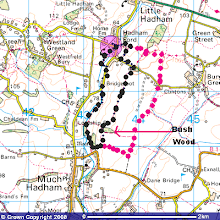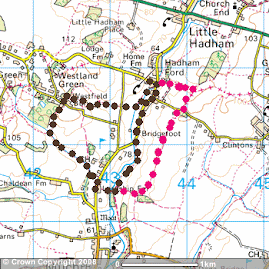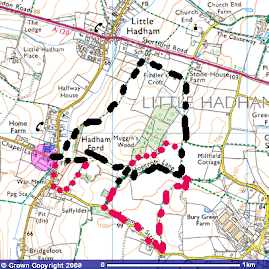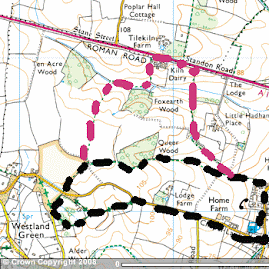On the 1st of July I had recorded 197 macro species and 131 micro species with, in total, 4166 moths identified.
By 30th September these numbers had increased tom 266 macro species and 185 micro species of 9445 moths in total. Consequently, as expected, the 3rd quarter of the year is a busy time, with traps not going on until 9.30 and several nights per week trapping until the small hours.
July began warmish, without too much in the way of night time high temperatures, but 100 moths in the 125MV garden skinner trap were common as were 70+ in the battery powered 15W heath trap, placed at a variety of parish locations.
The 1st week of July saw additions to the year list, namely:
Agriphila straminella
Caloptilia betulicola
Agriphila geniculea
Acentria ephemerella
Shaded broad bar
Oak eggar
Yellowtail (200th macro species for 2017)
Black arches
Cochylis hybridella
Psoricoptera gibbosella (New for parish records)
Spilonota ocellana
Bordered beauty
Acleris variegana
Galleria mellonella
Pandemis heparana
Acrobasis advenella
Grey dagger (gen det GJS)
Large emerald
Stathmopeda pedella (New for parish records)
Eulamprotes atrella (New for parish records)
Scarce silver lines (New for parish records)
Gypsonoma dealbana
Argyresthia pruniella
Helcystogramma rufescens
Prays fraxinella
Epinotia signatana (new for parish records)
Dark umber
Agonopterix alstromeriana
Monochroa palustrellus
Lunar spotted pinion
Slender brindle (new for parish records)
Lesser broad bordered yellow underwing
Silver Y
Phycita roborella
Caloptilia cucupennella
Marbled white spot (new for parish records)
Buff arches
Magpie
Ruby Tiger
Lesser common rustic
Common rustic
The list here is a long one due to the fact that the last 21 species were all trapped on a night (7th) where 5 traps were run for a community event in Millennium Wood. These traps ranged from 15W to 150 MV watt, plus several folk netting with headtorches.
The 5000 moth of the year was taken on this night, a Hedya nubiferana.
 |
| Acentria emphemerella |
 |
| Oak eggar |
 |
| Black arches |
 |
| Prays fraxinella |
 |
| Bordered beauty |
 |
| Large emerald |
 |
| Stathmopeda pedella |
 |
| Scarce silver lines |
A trip to Sri Lanka between 11th and 19th July halted progress, but not before a few more expected regulars made the year list. Upon my return, a Yarrow pug on the 21st was a new for parish record, as was a Least yellow underwing on the 25th.
A Bordered pug on the 26th was another parish record. My 6000th moth of the year was an
Agapeta hamana on the 30th and July concluded with 6088 moths identified, of 224 macros and 172 micros. Indeed, a busy month.
 |
| Bordered pug |
 |
| Least Yellow underwing |
August and a trip to local Suffyldes Wood on a warm night. In total: 60 moths + with a Lesser spotted pinion being a new addition to the parish list and a Cabbage moth making the year list. Over the following few weeks, new for years were very frequent and a
Yponomeuta plumbella was the 400th moth species for the year.
On the 3rd August, a pleasant surprise, with a Garden tiger, new for records in the garden along with the first of many orange swifts. The same night the first Straw underwings hinted at forthcoming autumn. I was still trapping plenty of moths, just nothing new for year or parish. An
Agriphila tristella was 7000th moth of the year on the 16th before a Wood carpet was a pleasing find, both in the garden trap and at Suffyldes Wood on the 16th.
The following night brought a Jersey Tiger, basically an annual visitor to both garden (on buddleia) and on the trap.
 |
| Yponomeuta evonymella |
 |
| Garden carpet (new for parish records) |
 |
| Jersey tiger |
 |
| Wood carpet. |
The new for year records continued:
Udea ferrugalis (18th,)
Agriphila selasella (20th,) Old Lady (23rd,) whilst a very worn Clay triple lines, also 23rd was a new for the parish records. My 8000th moth for the year was a Flame shoulder on the 27th, which also saw a Pinion streaked snout being new for the year. The month concluded with another new parish record of
Endothenia marginana on the 28th along with
Ypsolopha dentella as new for the year and, finally, a small wainscot on the 28th.
The 30th was the coldest night since early March, with just 33 moths trapped in total from Chapel Lane and garden. This total included 13 Setaceous hebrew characters.
 |
| Udea ferrugalis |
 |
| Old Lady |
 |
| Clay triple lines |
 |
| Ypsolopha dentella |
The 250th macro moth for the year, a Feathered gothic, arrived on 1st of September, a Red underwing (2nd) followed the next day be another new for parish record of
Argyresthia semifusca. An
Acleris emargana was trapped on the local golf course on the 4th, as was a Centre barred sallow and a final new for parish records for the year so far, an
Anacampsis populella, identified by gen det. At home on the same night, an Oak hooktip was new for year. Things were now beginning to quieten down, with totals per night dropping below 50 moths of less than 25 species. A Snout was the 9000th moth identified for the year on the 7th September. The 9th was a particularly cold night with a bright moon, leading to just 6 moths trapped. The final micro new for year record so far for 2017 was a Ypsolopha sequella, taken at Westland Green on the 11th . Further addtions came in the form of Turnip moth (12th,) Brown spot pinion (13th,) and on a very cold 14th, a Black rustic. This was the last new for year moth before a week's break in Kefalonia.
On the 24th, a Barred sallow, Mallow and Lunar underwing were all NFY whilst on the 25th Beaded chestnut and Grey pine carpet made the year list and these were followed the next night by a Sallow.
The 27th gave up Large ranunculus. A Pink barred sallow was the penultimate moth new for year of the third quarter with a Red line quaker being the final moth, taken on the 30th.
Recent annual total comparisons up to 30.ix.17. These statistics don't stand too much scrutiny as in 2014 I only had the garden Skinner 125MV trap which I occasionally took out with a generator, 2015 found me out in the evening with head torch and net at a variety of sites, whilst 2016 saw the addition of the portable Heath 15watt trap as from mid March. The reason the micros are down this year compared to 2016 is I have done considerably less day time flushing and netting of micros from grassland areas within the parish, especially the golf course and Westland Green.
2014: 3498 moths, 195 macros 120 micros
2015: 5620 moths, 196 macros 180 micros
2016: 9104 moths, 242 macros 221 micros
2017: 9445 moths, 266 macros 185 micros
 |
| Feathered gothic |
 |
| Argyresthia semifusca |
 |
| Acleris emargana |
 |
| Centre barred sallow |
 |
| Barred sallow |
 |
| Sallow |
 |
| Oak hooktip |
 |
| Turnip moth |
 |
| Ypsolopha sequella |
 |
| Mallow |
 |
| Feathered gothic |
 |
| Red line quaker |
Final installment near the end of December. By then hopefully will be past 10,000 moths of over 500 species. Now is the time of year where I am out and about checking for leaf mine evidence of larvae of micro moths such as this:
 |
| Leaf mine of Stigmella aurella found on bramble throughout the parish |
Last year I finished with 11,130 moths identified made up of 255 macros and 259 micros, 514 species in total. With a little searching this should well be within my compass this year.











































































































